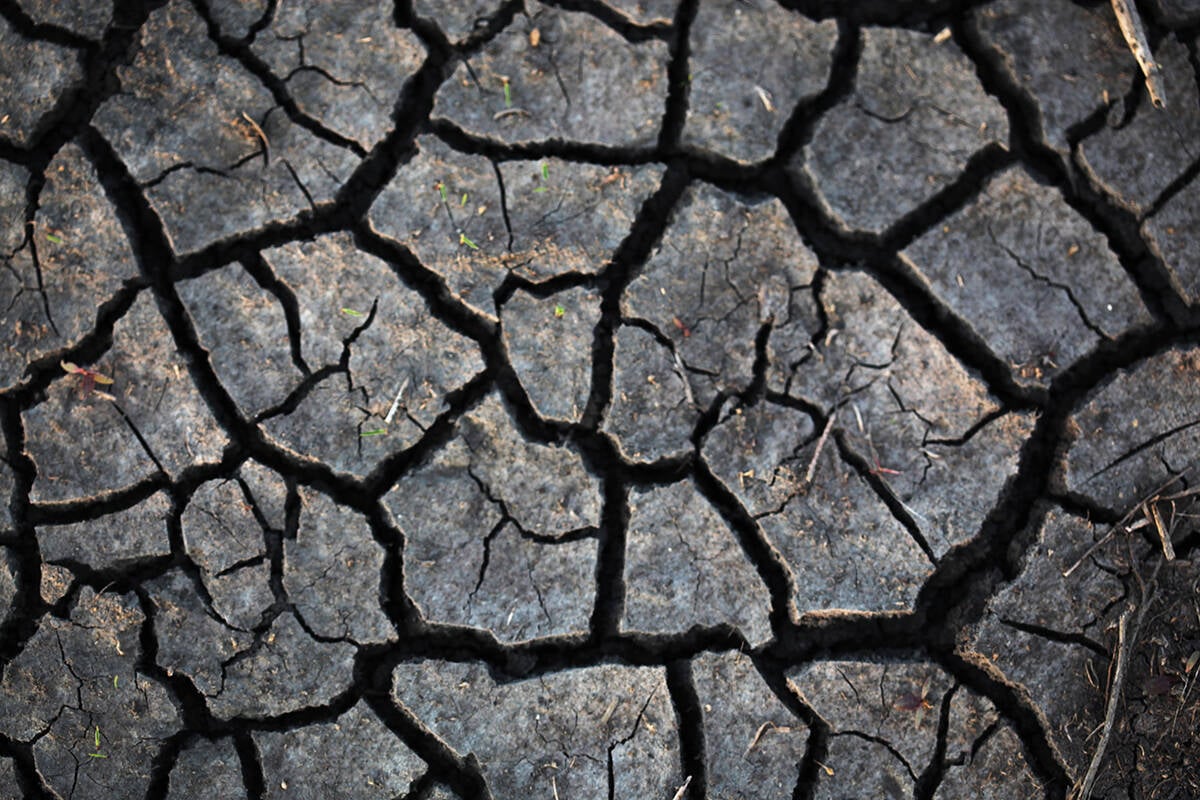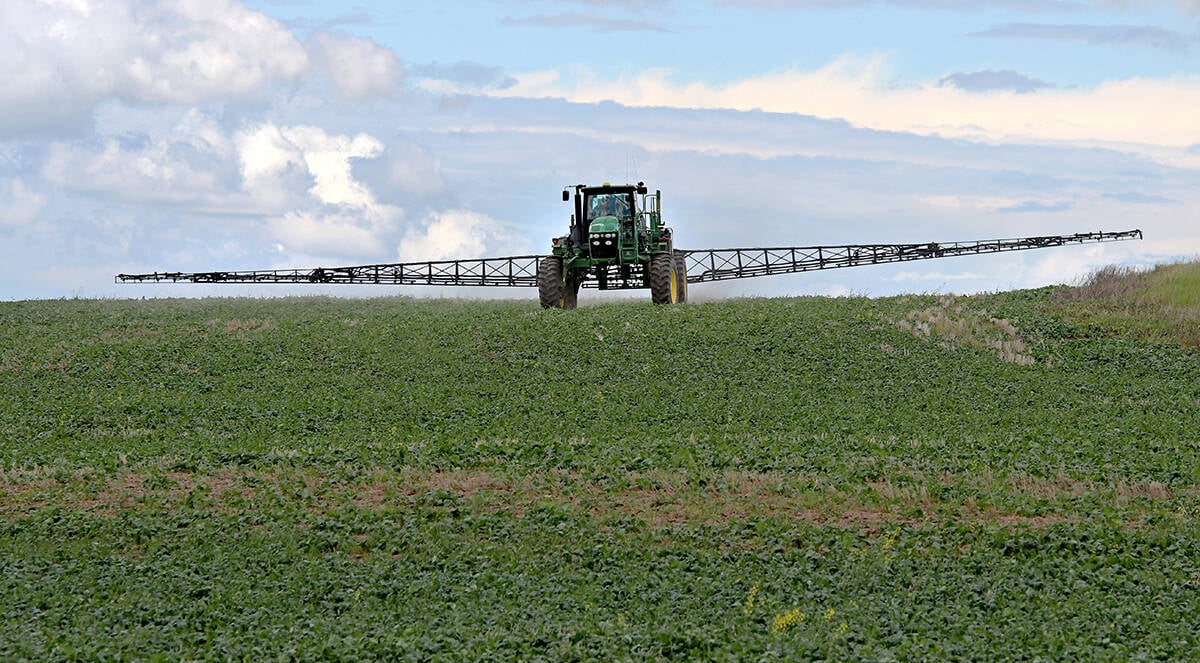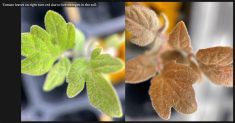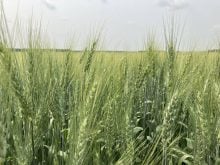SASKATOON — Crop input prices are under scrutiny in the United States.
The U.S. Department of Justice and the U.S. Department of Agriculture have signed a memorandum of understanding to investigate rising seed, fertilizer and pesticide costs.
It was also the subject of a recent hearing by the U.S. Senate’s judiciary committee.
Read Also

Prairies have variable soil moisture conditions
The dry weather in the west was welcome for preserving grain quality and advancing harvest, but it has resulted in very dry soil moisture conditions.
Why it Matters: High input costs are squeezing farm margins.
Keith Currie, president of the Canadian Federation of Agriculture, said there are no similar antitrust investigations happening in Canada.
“The horse has already left the barn in a lot of cases because there has been such consolidation,” he said.
“This type of looking into things should have happened a long time ago.”
The CFA would like the Competition Bureau to revisit its approval of Bunge Ltd.’s US$8.2 billion acquisition of Viterra Ltd.
Currie said the review was too focused on high-level issues and did not pay enough attention to people on the ground.
“We’ve heard from dozens of producer groups saying this is going to be a problem long-term down the road when these two massive organizations combine into one,” he said.
The U.S. Senate committee got an earful from producers on the ground during an Oct. 28 hearing.
Noah Coppess, a member of the Iowa Farm Bureau, told senators that the post-COVID inflationary environment, combined with the Russia-Ukraine war, caused input prices to skyrocket after 2020.
But while corn and soybean prices fell substantially in 2023 and slid further in 2024, input prices have remained elevated.
The average Iowa cash price for corn fell to US$4.40 per bushel in 2024 from $6.62 in 2022, while soybean values plunged to $9.95 from $14.20.
Meanwhile, seed, fertilizer and chemical costs increased slightly to $425.60 per acre from $415.55 over that same timeframe.
Consequently, net farm income in Iowa fell 53 per cent to $7 billion in 2024 from $14.87 billion two years earlier.
“Input prices that follow commodity prices quickly upward but slowly downward raise many questions about the pricing practices of production input suppliers,” Coppess said in his testimony to the committee.
He said the lack of competition is leading to behavior that would otherwise not be possible.
“For example, the Mosaic Company, one of the world’s largest phosphate producers, pushed for and successfully obtained countervailing duties on phosphate imports from Morocco and Russia during a period of exceptionally high fertilizer prices,” said Coppess.
John Latham, president of Latham Quality Inc., an independent seed company, said independent input companies are being forced out of business by increasingly powerful and predatory multinationals.
“The seed corn industry is 90 per cent controlled by two companies, including their own brands and licensing,” he said in his testimony to the committee.
“Due to this massive consolidation, the price of seed technology has risen sharply since 2021.”
Latham said farmers are still paying billions of dollars for seed royalties on the glyphosate resistance trait that has been off patent for three years.
“Why? Big-tech seed companies are manipulating the system that is supposed to allow post-patent competition,” he said.
“These companies can monopolize a technology well beyond the 20-year patent by using restrictive licensing agreements and stacking components on products to prevent competition.”
Latham said small independent seed companies are forced to license technology from their largest competitor.
That competitor drives up the price and requires the independent to provide them with all their financial and customer information.
And the independent is not given final pricing until after their crop is in the ground.
“So few companies control the industry that the monopolists write the rules,” said Latham.
His technology royalties have risen by 40 to 80 per cent between 2021 and 2025, even for products with 15-year-old genetics and a 20-year-old trait patent.
Latham said input prices have risen so much that farmers can’t be profitable on $4 corn and $10 soybeans.
Caleb Ragland, president of the American Soybean Association, said U.S. farm bankruptcies in 2024 were up 55 per cent over the previous year.
And in the first half of 2025 there were 57 per cent more than the same period a year ago. The U.S. has lost 20,000 farms in the past two years.
“This is a deeply concerning trend that is illustrative of what occurs when farmers have depleted their safety nets due to rising costs and lower crop prices,” he said.
Over the past five years, seed prices have increased 18 per cent, fertilizer is up 37 per cent, pesticides jumped 25 per cent and fuel expenses soared 32 per cent, according to the USDA’s Economic Research Service.
Ragland said new tariffs are partially to blame for the price hikes. U.S. farmers import $33 billion of crop inputs per year.
The overall tariff rate on agriculture inputs now averages 12.2 per cent compared to one per cent before the new International Emergency Economic Powers Act tariffs were introduced, according to North Dakota State University’s Agricultural Trade Monitor.
He also pointed a finger at excessive government regulation, noting that it takes an average of 12.3 years and $301 million to deliver a new pesticide to the market and 16.5 years and $115 million to launch a new seed trait.
“While the process of registering new products is increasingly time-consuming and arduous, the ability to maintain a product registration is in jeopardy,” said Ragland.
“There is a growing frequency of activist lawsuits targeting pesticidal products integral to farming operations.”
Corey Rosenbusch, president of the Fertilizer Institute, contends that the fertilizer market is highly competitive.
“The United States is a net fertilizer importer, and our members compete fiercely with each other and hundreds of global competitors in a robust, global fertilizer market,” he said in his testimony.
Rosenbusch said geopolitical events have been the biggest culprit behind the rise in fertilizer prices.
China began imposing export restrictions on its fertilizer products in 2021. Prior to 2021, it was the world’s largest exporter of phosphate and among the top tree exporters of nitrogen.
The Russian war in Ukraine was also “highly disruptive.” Russia is the biggest global supplier of fertilizers, but that supply chain was disrupted by economic sanctions imposed by several nations.
Russia also restricted Europe’s natural gas supply, which is used for fertilizer production.
“This resulted in approximately 70 per cent of European nitrogen fertilizer production shutting down in 2022 due to high natural gas costs,” said Rosenbusch.
High natural gas prices and supply problems in Europe, Egypt, Iran and Trinidad are impacting the supply of fertilizers to the U.S.
Andrew LaVigne, president of the American Seed Trade Association, said almost 40 per cent of the cost of bringing a biotech variety to market is tied to regulatory compliance.
Seed producers are shouldering the same inflationary pressures as farmers, with rising input, labour, land and transportation costs.
The continued escalation of tariffs is also taking a toll on the seed industry.
“Our industry believes there is a path forward to alleviate some of the pressures that both farmers and seed producers currently face,” said LaVigne.
The association is pushing for “risk-proportionate, science-based regulatory reform.”
“Reforms should right-size regulatory compliance processes and their associated costs for companies of all sizes,” he said.
It would also like to see public and private research partnerships for low acreage crops and strong intellectual property protection to encourage private investment in innovation.
Diana Moss, vice president of the Progressive Policy Institute, said the price of corn, soybean and cotton seed rose by an average of 463 per cent between 1990 and 2020 compared to general commodity price inflation of 56 per cent over that same period.
She said that is due to consolidation in the seed industry. Bayer and Corteva control 72 per cent of the corn market and 66 per cent of the soybean market.
“These combined shares signal extremely high levels of market concentration, which is generally associated with higher prices, lower quality and less innovation,” she said.

Syngenta is the other firm forming the Big 3 in the agricultural biotechnology business.
On the fertilizer side, anhydrous ammonia prices more than doubled between the fall of 2021 and the spring of 2022, topping out at a record $1,300 per ton, which squeezed corn margins.
Moss said fertilizer prices don’t seem to follow typical demand patterns.
“Instead, price patterns marked by an unexplainable price spike, followed by a price decrease, then another price spike, may well indicate anticompetitive co-ordination,” she said.
CF Industries, Kock Industries and Nutrien control 74 to 82 per cent of the nitrogen fertilizer production capacity in the U.S.
The institute said large mergers in the crop input business have been allowed with minimal fixes, and concerns over price fixing or market manipulation have gone largely unpursued.
“A permissive antitrust stance on agricultural input mergers and business practices have fostered highly concentrated markets in supply chains that feature little competition and weak incentives to compete hard on price, quality and innovation,” said Moss.
Currie said the lack of competition in Canada’s crop input sector has been a longstanding problem.
“I don’t know if there’s a simple answer to fix it,” he said.
Part of the problem is the demise of government research and development programs.
One area where there could be a fix is making Canada more competitive with competing jurisdictions when it comes to approving new technologies.
Currie said farmers in the U.S., Australia and the European Union seem to get their hands on new technologies faster than Canadian growers.
He would like to see more harmonization in regulations with these trusted jurisdictions.
“Why can’t we peer review what they’ve done and maybe give us access to products that we don’t have now?” he said.
















